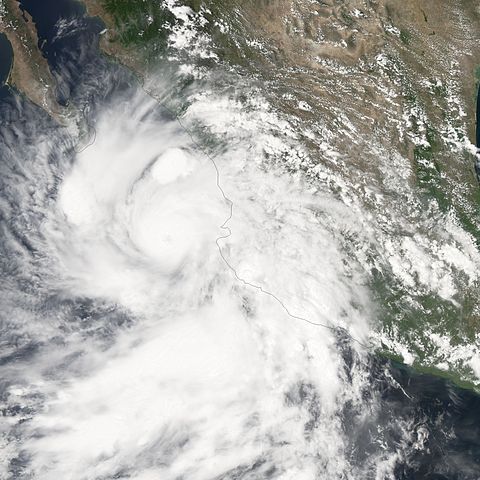 |
This is a file from the Wikimedia Commons. Information from its description page there is shown below.
Commons is a freely licensed media file repository. You can help.
|
Summary
| Description |
As of September 1, 2006, Hurricane John had been lashing the Mexican Pacific coast for several days. The storm system center was remaining offshore and predictions held that it would only briefly come ashore as it clipped the southern tip of Mexico’s Baja California on its track up along the Pacific coast. It is unusual for a eastern Pacific hurricane to come ashore without breaking apart into a lesser storm system because of prevailing wind patterns and cold water upwelling along the coast. Hurricane John, however, has managed to run parallel to the Mexican coast for several days. The most powerful hurricane force winds were not over land, but the Category Four hurricane was large enough to bring strong winds and heavy surf to the coastal areas. This photo-like image was acquired by the Moderate Resolution Imaging Spectroradiometer (MODIS) on the Aqua satellite on August 31 2006, at 2:10 p.m. local time (20:10 UTC). Hurricane John at the time of this image had a well-defined if widespread shape, spiral arm structure, and a cloud-filled (“closed”) eye. Hurricane John had sustained winds of around 165 kilometers per hour (105 miles per hour) at the time this satellite image was acquired, according to The University of Hawaii’s Tropical Storm information centre. This was somewhat less powerful than two days earlier when Category Four strength winds were measured in the central parts of the hurricane |
| Date |
31 August 2006 |
| Source |
http://earthobservatory.nasa.gov/NaturalHazards/natural_hazards_v2.php3?img_id=13830 |
| Author |
NASA image created by Jesse Allen, Earth Observatory, using data provided courtesy of the MODIS Rapid Response team. |
Permission
( Reusing this file) |
| Public domainPublic domainfalsefalse |
 |
This file is in the public domain because it was solely created by NASA. NASA copyright policy states that "NASA material is not protected by copyright unless noted". (See Template:PD-USGov, NASA copyright policy page or JPL Image Use Policy.) |
|
|
|
Warnings:
- Use of NASA logos, insignia and emblems are restricted per US law 14 CFR 1221.
- The NASA website hosts a large number of images from the Soviet/ Russian space agency, and other non-American space agencies. These are not necessarily in the public domain.
- Materials based on Hubble Space Telescope data may be copyrighted if they are not explicitly produced by the STScI. See also {{ PD-Hubble}} and {{ Cc-Hubble}}.
- The SOHO (ESA & NASA) joint project implies that all materials created by its probe are copyrighted and require permission for commercial non-educational use.
- Images featured on the Astronomy Picture of the Day (APOD) web site may be copyrighted.
|
|
File usage
The following pages on Schools Wikipedia link to this image (list may be incomplete):
SOS Childrens Villages has brought Wikipedia to the classroom. SOS Children's Villages believes that a decent childhood is essential to a happy, healthy. Our community work brings families new opportunities through education, healthcare and all manner of support. Find out more about sponsoring a child.





